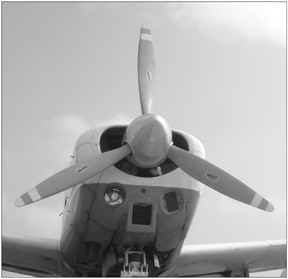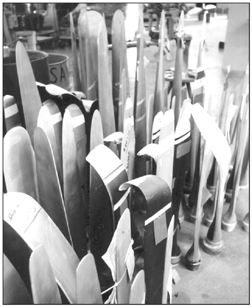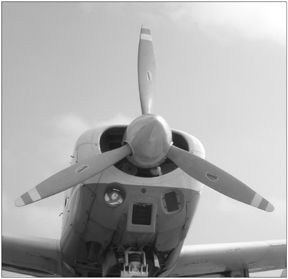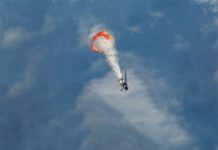
by Rick Durden
The photo to the right has a certain startling quality. Its of the business end of a 30-year-old, 180-HP Mooney with a newish three-blade prop in place of the two-blade model the factory installed on the airplane.Depending on your point of view, it looks either rakishly sexy or slightly out of place, like white walls on a Jaguar.
Either way, the Mooney is part of a growing fleet of airplanes that have converted to three-blade props. When last we examined this topic seven years ago, the three-blade trend was just emerging and we concluded then that much of what drove owners to make the switch was that three-blade props just look cooler.
We concluded that three-blade props were smoother and quieter than the two-blade variety and that most owners noticed slightly shorter takeoff rolls and marginally better climb rates. But on airplanes with under 300 HP, cruise speed suffered as much as 5 knots. We wondered if the then-new scimitar props would improve cruise speed loss. In the nearly decade that has elapsed, one would think that definitive answers on whether to convert to three blades from two would be evident. One would be wrong. We can find no slam dunk data one way or another. We listened to owners and prop shop operators until our ears rang and our conclusion remains: For most airplanes, converting to a three-blade is subjective and intensely aesthetic. In short, its a guy thing.
While feedback is sketchy, it appears that the new scimitar props are the least likely to depress cruise speed and, especially for higher powered engines, may even yield a slight cruise improvement. The scimitars have worked for the Lancair Columbia 400 and other new models.
But absent comparative propeller cruise performance data, we strongly suspect three-blades are the way to go mainly for high horsepower applications-250 HP and higher. A consistent message we heard from prop shops was that the Hartzell scimitar prop on the Beechcraft Bonanza was yielding a measurable increase in cruise speed.
But, alas, few of the owners we interviewed have hard before-and-after performance data on their three-blade conversions, largely because owners made the purchase decision after that heartburn-inducing call from the prop shop reporting that the old prop was junk.
Some History
The marketing push for three-blade props traces its history to the sales collapse of the mid-1980s, when Hartzell and McCauley, faced with plummeting demand, scrambled to invent new products that would appeal to owners of existing airplanes via STCs. McCauleys aggressive-looking Black Mac line of three- and four-blade props was matched by Hartzell, with its equally sharp Top Prop line.
Both companies hustled to certify three-blade props for as many airplanes as possible. An examination of their respective Web sites reveals an ever-increasing fleet of airplanes for which the factory-issued two-blade club can be replaced by a three-blade prop. New models are added constantly.
In the late 1990s, ADs, notably on Hartzell props, resulted in many owners suddenly being confronted with a mandatory overhaul. According to prop shops, the rejection rate on props flown under 100 hours a year ran in the 60 to 70 percent range, due to corrosion and repeated filing until the blades were below spec.
For many owners, a new prop was the only alternative. Hartzell and McCauley reacted by pricing their new three-blade props below the cost of a two-blade model. That, combined with the pure sex appeal of three-blades, sold a lot of props. Some owners also bought lightweight starters at the same time, negating the 10-pound weight increase due to the extra blade.
Prop shops told us that in addition to AD-induced demand, aggressive marketing of three-blade props also resulted in hundreds of about-to-give-up-the-ghost old props being replaced with new, three-blade equipment. In our view, its one of the few times that selling sex has resulted in selling safety. A new prop is simply safer than a tapped out older one, regardless of how many blades it has.
To get a feel for the strains on a prop, think about the last time you swung a 32-ounce Louisville Slugger hard and felt the pull on your arms and shoulders. Now consider the force generated by the inertia of a 40-inch, 10-pound hunk of aluminum whirling at 2600 RPM while subjected to the twisting of air loads and vibrations of an engine with pistons slamming to a stop and reversing direction a few dozen times a second. Then think about how corrosion and stress cracks compromise a props ability to endure such punishment. (Try not to think about a blade departing the airplane.)
Three-Blade Theory
From an efficiency standpoint, the fewer the blades and the lower the RPM, up to a point, the better. For our relatively low horsepower airplanes, it doesnt take a lot of blades to absorb the horsepower and convert it to thrust. Prop manufacturers have spent years and millions of dollars to come up with the best prop for all of the variables involved.
Although a single-blade prop is the theoretical max performer, for years, two-blade propellers have proven the best combination of efficiency and thrust and they avoid cavitation when one blade doesnt advance far enough to get into clean air from the preceding blade during rotation. Higher power engines require more blades to absorb the power and avoid cavitation because the aircraft to which theyre attached travels further per revolution of the prop than slower airplanes with fewer blades.
But there’s a tradeoff. Because of a combination of weight, induced drag from the extra blade and more required taildown force to offset the weight, three-blade props may extract a cruise-speed penalty. Sometimes its a little, sometimes a lot. Generally, the lower the horsepower, the more likely the cruise speed loss will be noticeable.
For all props, tip shape is an important variable. Square tips gave way to elliptical tips for reduced drag. As interest in three-blade props for modest engines increased, more R&D went into addressing the cruise speed problem.Thus comes the most recent development: The scimitar tip, along with a blended airfoil, which seems to give the best combination of thrust with the least drag.
On its Web site, Hartzell says that converting from a two-blade to a three-blade propeller generally improves takeoff and climb performance, while cruise speeds remain about the same. We think this claim is we’ll supported by our talks with shops, owners and our own experiences. However, the climb gains may be modest and could easily be disguised by weight and density altitude variations.
Further, its not unusual for a three-blade prop to knock a couple of knots off cruise speed.
One testimonial from a Mooney owner on Hartzells Web site claims a two- to four-knot cruise speed improvement but were skeptical of this claim. In 1998, when Mooney was recertifying the K-model for its brief reintroduction as the Encore, it tested three-blade propellers and found that cruise speed losses were unacceptable in a low horsepower airplane.
The new M20K was reissued with the two-blade prop it had always had. Furthermore, 252s converted to three-blade props in Europe for noise abatement reasons suffered cruise speed losses of 4 to 6 knots, according to Mooney.
On high horsepower engines-say 300 HP and above-its a different story. Mooneys data indicated that with that much power, the extra blade is useful in efficiently converting power to thrust, which is why airplanes such as the Ovation, Bravo and Lancair have three-blade props. Two-blade models would clearly depress climb rates and increase takeoff distances.

Which Manufacturer?
When we asked for manufacturer recommendations from shops not tied to Hartzell or McCauley, our survey split down the middle. Those who preferred McCauley liked its one-piece hub and its continuous oil lubrication, as we’ll as the fact that McCauley props are subject to fewer ADs than are Hartzells.
Those who liked Hartzell props downplayed the ADs and said that the grease-filled hub allowed for replacement of the grease every 100 hours so that air and moisture were driven out along with the old grease, plus Hartzells are less expensive.
The shops were absolutely unanimous in asserting that the enemy of props is neglect and lack of use. We were told that every new prop AD brought owners out of the woodwork along with their grievously neglected props, some with innards so corroded that a tossed blade was a near certainty. From a maintenance point of view, if an owner is determined to neglect his prop, shops say that the McCauley single-piece hub stands up to such misuse better than the Hartzell.
Interestingly, while Hartzells are cheaper to buy, they are more expensive to overhaul. We were told that for a Bonanza, for example, overhauling an older Hartzell two-blade prop-assuming all parts can be reused-costs $2500.For a new Hartzell three-blade prop, the basic overhaul cost is $1750. For an older McCauley two-blade, an overhaul would run $1700, while the new three-blade overhaul will cost $1550, nearly $1000 less than the Hartzell.
Recommendations
If your prop is approaching overhaul, don’t put it off: Budget the time and money and make the decision. But what decision? First, go flying and collect some accurate speed data on how the airplane performs with its current prop. (See the November 2004 issue of Aviation Consumer for a simple test method.)
Assuming your old two-blade prop is due for an overhaul on time or condition and is serviceable, we think it makes sense to price the overhaul against a new three-blade prop. The chart on page 19 provides a glimpse of prices. These don’t apply across the board so you’ll have to check your specific model. Typically, a new three-blade model will cost more than a new two-blade and a bit more than three times as much as an overhaul. In this case, if youre happy with cruise speed, noise and vibes, its an easy call: Overhaul the two-blade.
If the two-blade is junk, the decision isn’t so simple. We think you should at least put a sharp pencil to the numbers on converting to a three-blade. Try to get an agreement with the shop that if you buy a three-blade and you don’t like it, you can get near full credit after a reasonable time-say 30 days-toward a trade-in on a two-blade. Any performance change with a three-blade may be small so don’t get too excited about losing a knot or two. On a 250-mile trip, the faster airplane will be rolling out on the runway as the slower one enters the pattern.
Vibration and perceived noise are subjective. The three-blade will feel and sound different and you’ll either like it or you wont. If you don’t, inform the shop within a week or two to make the swap back to a two-blade. If you have an older Cessna 180 or 182, a Comanche 250 or an early Cessna 310, were wary of recommending three-blade props for these models. In our view, the performance gains are nil against the risk of an unpleasant vibe signature.
Over the past five or six years, the sales of three-blade props has leveled off, although a couple of the prop shops we talked with said there’s a bump every five years as a 1997 Hartzell recurring AD comes due. Some owners whose older props survived the first AD-mandated inspection discovered that they couldnt cut it the second time around.
Even with the maturing of the three-blade prop conversion market, the shops we interviewed were unanimous in saying that the decision to go to a three-blade prop is largely emotional.
A Mississippi shop said that owners who spend a bunch of money on paint and interior to make their airplanes look nice can also be expected to finish the process by hanging a high-testosterone, three-blade prop on the front end.
Also With This Article
“Three-blade Prop Sample Prices”
“What Owners Say”
Contacts
Hartzell Propeller Inc., 937-778-4200, www.topprop.com
McCauley Propeller Systems, 800-621-7767, www.mccauley.textron.com
-Rick Durden is an Aviation Consumer contributing editor.





